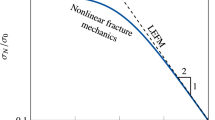Abstract
The stress-separation curve obtained for the in-situ response of first-year sea ice is used to obtain specimen size requirements for sea ice fracture tests. Issues of notch sensitivity and minimum size requirements for the applicability of linear elastic fracture mechanics are addressed. The role of time dependent deformations in studying sea ice fracture is examined.
Similar content being viewed by others
References
Abdel-Tawab, K. and Rodin G.J. (1993a). On the relevance of linear elastic fracture mechanics to ice. International Journal of Fracture 62, 171–181.
Abdel-Tawab, K. and Rodin, G.J. (1993b). An interpretation of results of the fracture toughness tests on ice. In: Ice Mechanics 1993, AMD-Vol. 163, ASME, New York, 49–60.
Abdel-Tawab, K. (1995). Constitutive Modeling and Fracture Analysis of Ice.PhD Thesis, University of Texas at Austin.
Adamson, R.M. and Dempsey, J.P. (1998). Field-scale in-situ compliance of arctic first-year sea ice. ASCE Journal of Cold Regions Engineering 12, 52–63.
Adamson, R.M., Dempsey, J.P, DeFranco, S.J. and Xie, Y. (1995). Large-scale in-situ ice experiments, Part I: Experimental aspects. Ice Mechanics – 1995, AMD Vol. 207, ASME, New York, 107–128.
Adamson, R.M., Shapiro, L.H. and Dempsey, J.P. (1997). Core-based SCB fracture of aligned first-year sea ice (phases III and IV). ASCE Journal of Cold Regions Engineering 11, 30–44.
Bazant, Z.P., Bai, S-P and Gettu, R. (1993). Fracture of rock: Effect of loading rate. Engineering Fracture Mechanics 45, 393–398.
Bentley, D.L., Dempsey, J.P., Sodhi, D.S. and Wei, Y. (1989). Fracture toughness of columnar freshwater ice from large scale DCB tests. Cold Regions Science and Technology 17, 7–20.
Cole, D.M. (1995). A model for the anelastic straining of saline ice subjected to cyclic loading. Philosophical Magazine A 72, 231–248.
DeFranco, S.J. and Dempsey, J.P. (1994). Crack propagation and fracture resistance in saline ice. Journal of Glaciology 40, 451–462.
Dempsey J.P. (1991). The fracture toughness of ice. Ice-Structure Interaction(Edited by S.J. Jones, R.F. McKenna, J. Tillotson and I.J. Jordaan), Springer-Verlag, Berlin, Heidelberg, 109–145.
Dempsey, J.P. (1996). Scale effects on the fracture of ice. The Johannes Weertman Symposium(Edited by R.J. Arsenault, D. Cole, T. Gross, G. Kostorz, P.K. Liaw, S. Parameswaran and H. Sizek), The Minerals, Metals and Materials Society, 351–361.
Dempsey, J.P. and Palmer, A.C. (1999). Non-universal scaling of Arctic fractures. Proceedings. 15th International Conference on Port and Ocean Engineering under Arctic Conditions. (Edited by J. Tuhkuri and K. Riska), Helsinki University of Technology, Finland, Vol. 1, 11–24.
Dempsey, J.P., DeFranco, S.J., Adamson, R.M. and Mulmule, S.V. (1999a). Scale effects on the in-situ tensile strength and fracture of ice. Part I: Large grained freshwater ice at Spray Lakes Reservoir, Alberta. International Journal of Fracture 95, 325–345.
Dempsey, J.P., Adamson, R.M. and Mulmule, S.V. (1999b). Scale effects on the in-situ tensile strength and fracture of ice. Part II: First-year sea ice at Resolute, N.W.T. International Journal of Fracture 95, 347–366.
Elvin A.A. and Shyam Sunder, S. (1995). Microcracking due to grain boundary sliding in S2 ice under unaxial compression. Ice Mechanics – 1995, AMD Vol. 207, ASME, New York, 21–32.
Frost, H.J. (1995). Mechanisms of crack nucleation in ice. Ice Mechanics – 1995, AMD Vol. 207, ASME, New York, 1–8.
Goodman, D.J. (1980). Critical stress intensity factor (K Ic ) measurements at high loading rates for polycrystalline ice. Physics and Mechanics of Ice(Edited by P. Tryde), Copenhagen, 129–146.
Hillerborg, A., Modeer, M. and Petersson, P.E. (1976). Analysis of crack formation and crack growth in concrete by means of fracture mechanics and finite elements. Cement and Concrete Research 6, 773–782.
LeClair, E.S., Adamson, R.M. and Dempsey, J.P. (1997). Core-based SCB fracture of aligned first-year sea ice (Phase VI). ASCE Journal of Cold Regions Engineering 11, 45–58.
LeClair, E.S., Schapery, R.A. and Dempsey, J.P. (1999). A broad-spectrum constitutive modeling technique applied to saline ice. International Journal of Fracture(in press).
Mulmule, S.V. and Dempsey, J.P. (1997). Stress-separation curve for saline ice using the fictitious crack model. ASCE Journal of Engineering Mechanics 123, 870–877.
Mulmule, S.V. and Dempsey, J.P. (1998). Viscoelastic fictitious crack model for the fracture of sea ice. Mechanics of Time-Dependent Materials 1, 331–356.
Mulmule, S.V. and Dempsey, J.P. (1999). Scale effects on sea ice fracture. Mechanics of Cohesive-Frictional Materials 4(in press).
Mulmule, S.V., Adamson, R.M. and Dempsey, J.P. (1995). Large-scale in-situ fracture experiments. Part II: Modeling aspects. Ice Mechanics – 1995, AMD Vol. 207, ASME, New York, 107–128.
Petersson, P.E. (1981). Crack Growth and Formation of Fracture Zones in Plain Concrete and Similar Materials.Report TVBM-1006, Lund Institute of Technology, Division of Building Materials, Sweden.
Riedel, H. and Rice, J.R. (1980). Tensile cracks in creeping solids. Fracture Mechanics: Twelfth Conference, ASTM STP 700, American Society of Testing Materials, 112–130.
Schapery, R.A. (1997). Thermoviscoelastic constitutive equations for polycrystalline ice. ASCE Journal of Cold Regions Engineering 11, 146–157.
Schapery, R.A. (1975). A theory of crack initiation and growth in viscoelastic media. II. Approximate method of analysis. International Journal of Fracture 11, 369–387.
Shyam Sunder, S. and Nanthikesan, S. (1992). Fracture process zone due to transient creep in polycrystalline ice. IAHR Ice Symposium, Banff, Alberta, Vol. 2, 1006–1020.
Shyam Sunder, S. and Wu, M.S. (1990). Crack nucleation due to elastic anisotropy in polycrystalline ice. Cold Regions Science and Technology 18, 29–47.
Timco, G.W. and Frederking, R.M.W. (1986). The effects of anisotropy and microcracks on the fracture toughness (K Ic ) of freshwater ice. Proceedings 5th International Offshore Mechanics and Arctic Engineering Conference, Tokyo, 341–348.
Urabe, N. and Yoshitake, A. (1981). Strain rate dependent fracture toughness (KIc ) of pure ice and sea ice. IAHR Ice Symposium, 410–420.
Wei, Y., Johnston, M. and Dempsey J.P. (1995). A grain multiplication mechanism for the formation of transition zones in first year sea ice. Cold Regions Science and Technology 23, 367–375.
Author information
Authors and Affiliations
Rights and permissions
About this article
Cite this article
Mulmule, S., Dempsey, J. LEFM size requirements for the fracture testing of sea ice. International Journal of Fracture 102, 85–98 (2000). https://doi.org/10.1023/A:1007603428907
Issue Date:
DOI: https://doi.org/10.1023/A:1007603428907




